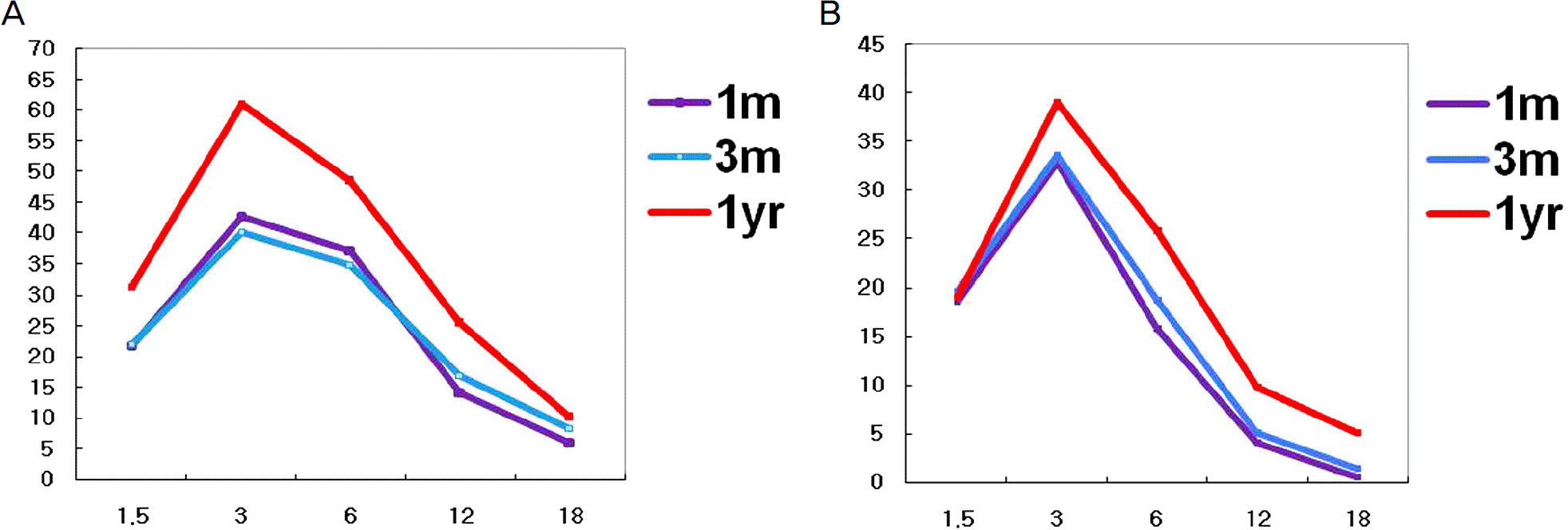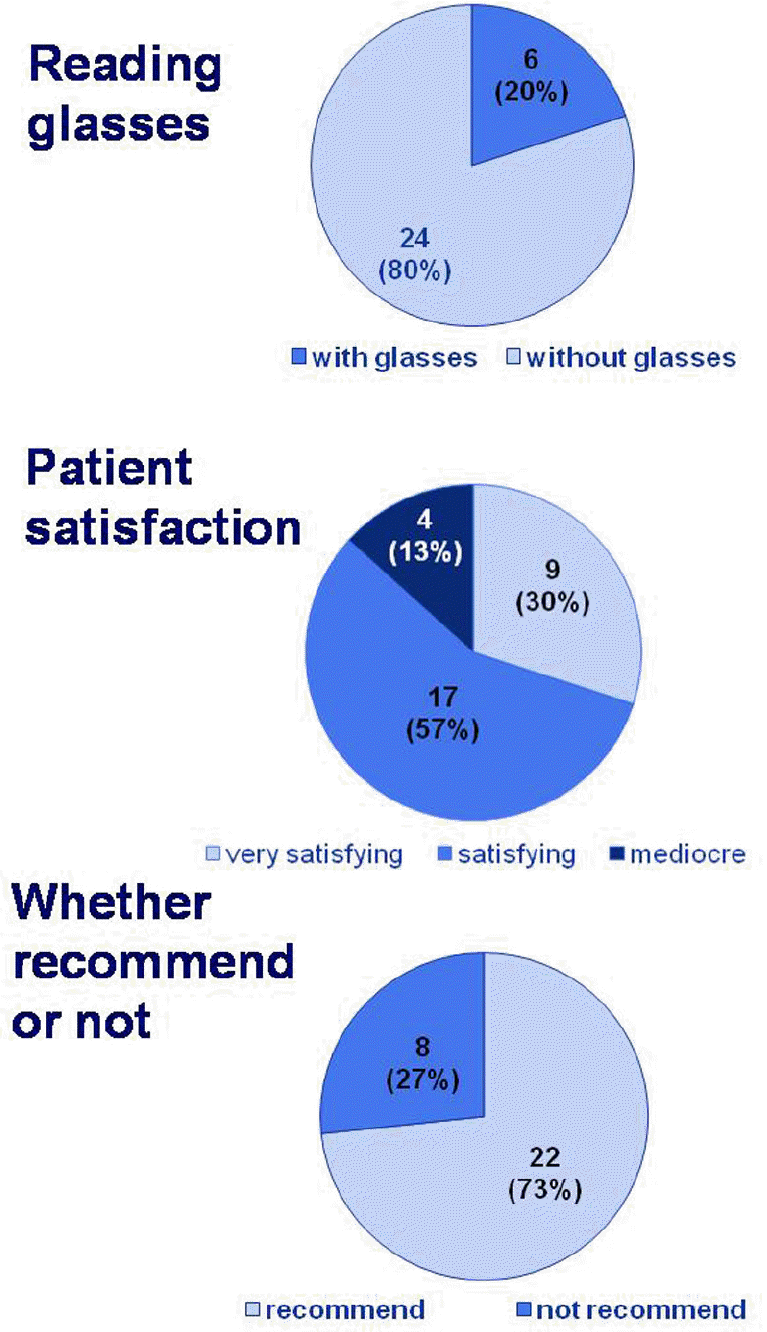Abstract
Purpose
To evaluate near and far visual acuity, subjective visual symptoms, and patient satisfaction with a monocular implant of aspheric multifocal IOL (AMO Tecnis ZM900®).
Methods
Thirty eyes of 30 patients received phacoemulsifications and monocular implantation of Tecnis ZM900 IOL. The main outcome measures at postoperative 1 week, 1 month, 3 months, and 1 year were uncorrected and corrected near and distant visual acuity, refractory errors, contrast sensitivity, subjective visual symptoms (glare and halo), spectacle independency, and satisfaction.
Results
At a 3 month postoperative visit, the mean uncorrected near and distant visual acuities were 0.29±0.17 (logMAR) and 0.16±0.12 (logMAR), respectively. At 1 year, the mean uncorrected near and distant visual acuities were 0.25±0.17 (logMAR) and 0.11±0.08 (logMAR). Glare and halo decreased, and contrast sensitivity increased upon 1-year follow-up after monocular implantation of ZM900. Most patients (87%) were satisfied with their visual outcome.
Conclusions
Monocular implantation of multifocal IOL Tecnis ZM900 shows stable surgical outcomes with a high satisfaction rate and enables a high rate of spectacle independency. Postoperative glare and halo, youth, and residual refractive error could be risk factors for dissatisfaction with monocular implantation of multifocal IOL Tecnis ZM900. Proper patient selection can lead to satisfying outcomes.
Go to : 
References
1. Goes FJ. Refractive lens exchange with the diffractive multifocal tecnis ZM900 intraocular lens. J Refract Surg. 2008; 24:243–50.

2. Lee DY, Roh JH, Shyn KH. Current trends in cataract surgery in Korea – 2005 survey for KSCRS members. J Korean Ophthalmol Soc. 2007; 48:485–92.
3. Fernández-Vega L, Alfonso JF, Rodríguez PP, Montés-Micó R. Clear lens extraction with multifocal apodized intraocular lens implantation. Ophthalmology. 2007; 114:1491–8.
4. Fernández-Vega L, Alfonso JF, Montés-Micó R, Amhaz H. Visual acuity tolerance to residual refractive errors in patients with an apodized diffractive intraocular lens. J Cataract Refract Surg. 2008; 34:199–204.

5. Claoué C, Parmar D. Multifocal intraocular lenses. Dev Ophthalmol. 2002; 34:217–37.
6. Monte´s-Mico´ R, Espana E, Bueno I, et al. Visual performance with multifocal intraocular lenses mesopic contrast sensitivity under distance and near conditions. Ophthalmology. 2004; 111:85–96.
7. Sen HN, Sarikkola A-U, Uusitalo RJ, Laatikainen L. Quality of vision after AMO Array multifocal intraocular lens implantation. J Cataract Refract Surg. 2004; 30:2483–93.

8. Schmitz S, Dick HB, Krummenauer F, et al. Contrast sensitivity and glare disability by halogen light after monofocal and multifocal lens implantation. Br J Ophthalmol. 2000; 84:1109–12.

9. Kamlesh , Dadeya S, Kaushik S. Contrast sensitivity and depth of focus with aspheric multifocal versus conventional monofocal intraocular lens. Can J Ophthalmol. 2001; 36:197–201.

10. Heo JY, Kim YH, Joo CK. Clinical results of AMO ARRAY multifocal intraocular lens. J Korean Ophthalmol Soc. 1999; 40:978–86.
11. Lee JM, Seo KY, Kim EK. Comparison of optical aberrations and contrast sensitivity between monofocal and multifocal intraocular lens. J Korean Ophthalmol Soc. 2002; 43:1882–6.
12. Song MJ, Lee MK, Park BI. A Clinical study of 3M multifocal intraocular lens implant. J Korean Ophthalmol Soc. 1991; 32:234–40.
13. Allen ED, Burton RL, Webber SK, et al. Comparison of a diffractive bifocal and a monofocal intraocular lens. J Cataract Refract Surg. 1996; 22:446–51.

14. Rossetti L, Carraro F, Rovati M, Orzalesi N. Performance of diffractive multifocal intraocular lenses in extracapsular cataractsurgery. J Cataract Refract Surg. 1994; 20:124–8.
15. Leyland MD, Langan L, Goolfee F, et al. Prospective randomized double-masked trial of bilateral multifocal, bifocal or monofocal intraocular lenses. Eye. 2002; 16:481–90.
16. Song MJ, Lee MK, Park BI. A Clinical study of 3M multifocal intraocular lens implant. J Korean Ophthalmol Soc. 1991; 32:234–40.
17. Kim YS, Han TW, Kim MS, Kim JH. Clinical experience of 3M multifocal intraocular lens implantation. J Korean Ophthalmol Soc. 1990; 31:1308–17.
18. Choi HS, Lim SJ, Kim HB. Clinical results of unilateral implantation of AMO Array multifocal intraocular lens. J Korean Ophthalmol Soc. 2001; 42:702–8.
19. Gray PJ, Lyall MG. Diffractive multifocal intraocular lens implants for unilateral cataracts in prepresbyopic patients. Br J Ophthalmol. 1992; 76:336–7.

20. Jacobi PC, Dietlein TS, Lu¨ke C, Jacobi FK. Multifocal intraocular lens implantation in prepresbyopic patients with unilateral cataract. Ophthalmology. 2002; 109:680–6.

21. Souza CE, Gerente VM, Chalita MR, et al. Visual acuity, contrast sensitivity, reading speed, and wavefront analysis; pseudophakic eye with multifocal IOL (ReSTOR) versus fellow phakic eye in non-presbyopic patients. J Refract Surg. 2006; 22:303–5.

22. Shoji N, Shimizu K. Binocular function of the patient with the refractive multifocal intraocular lens. J Cataract Refract Surg. 2002; 28:1012–7.

23. Häring G, Gronemeyer A, Hedderich J, de Decker W. Stereoacuity and aniseikonia after unilateral and bilateral implantation of the Array refractive multifocal intraocular lens. J Cataract Refract Surg. 1999; 25:1151–6.

24. Chang M, Eom Y, Kang SY, et al. Clinical outcome of diffractive multifocal aspheric intraocular lens. J Korean Ophthalmol Soc. 2009; 50:529–36.

25. Simpson MJ. The diffractive multifocal intraocular lens. Eur J Implant Ref Surg. 1989; 1:115–21.

26. Yoon JU, Chung JL, Hong JP, et al. Comparison of wavefront analysis and visual function between monofocal and multifocal aspheric intraocular lenses. J Korean Ophthalmol Soc. 2009; 50:195–201.

27. Mayer S, Böhm T, Häberle H, et al. Combined implantation of monofocal and multifocal intraocular lenses for presbyopia correction in cataract patients. Klin Monatsbl Augenheilkd. 2008; 225:812–7.
28. Cionni RJ, Osher RH, Snyder ME, Nordlund ML. Visual outcome comparison of unilateral versus bilateral implantation of apodized diffractive multifocal intraocular lenses after cataract extraction Prospective 6-month study. J Cataract Refract Surg. 2009; 35:1033–9.
Go to : 
 | Figure 1.Change in contrast sensitivity test at photopic condition (A) and mesopic condition (B) (*p<0.05). |
Table 1.
Patient characteristics
Table 2.
Postoperative distant visual acuity
Table 3.
Postoperative near visual acuity
Table 4.
Postoperative aberrations (mean± standard deviation)
| Postop 1 month | Postop 3 months | Postop 1 year | |
|---|---|---|---|
| RMS total (micron) | 0.96±0.35 | 0.85±0.36 | 0.83±0.47 |
| HOA (micron) | 0.23±0.06 | 0.13±0.10 | 0.12±0.10 |




 PDF
PDF ePub
ePub Citation
Citation Print
Print



 XML Download
XML Download